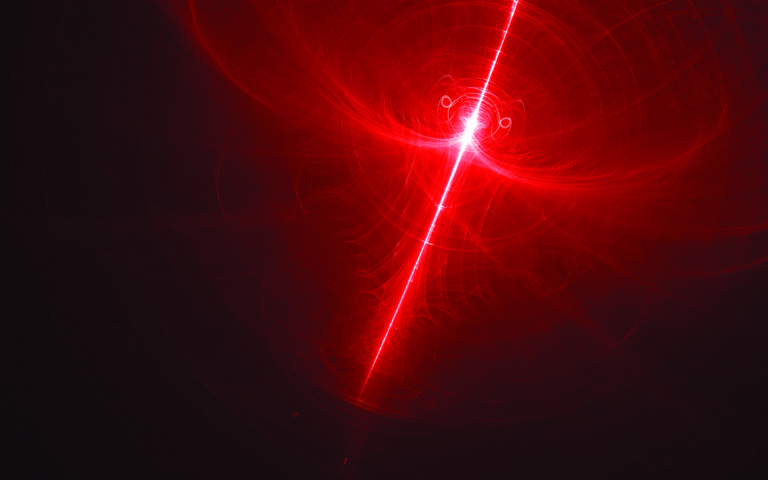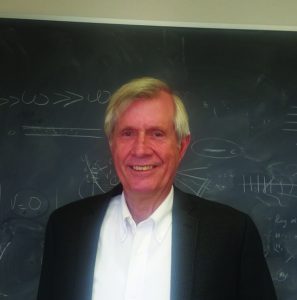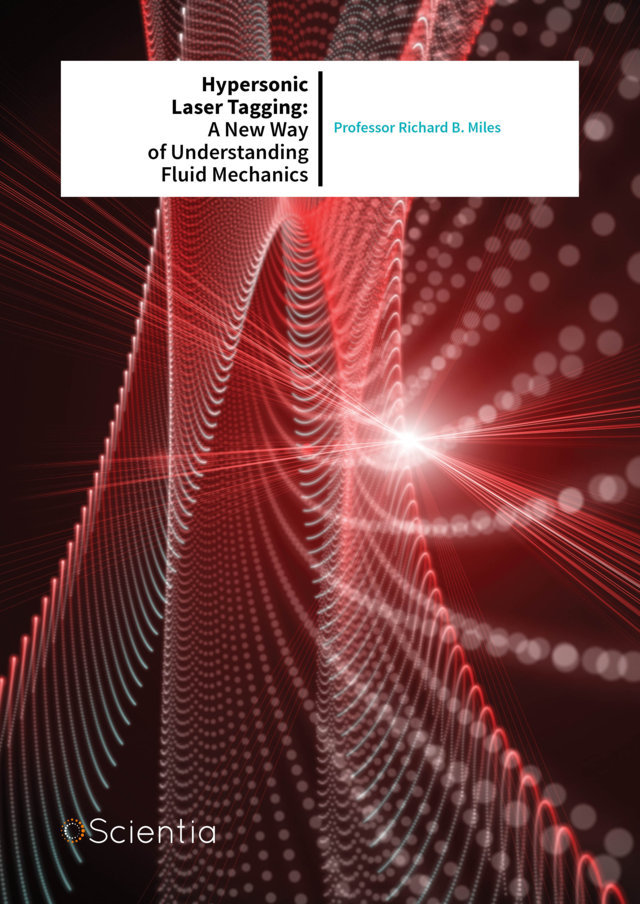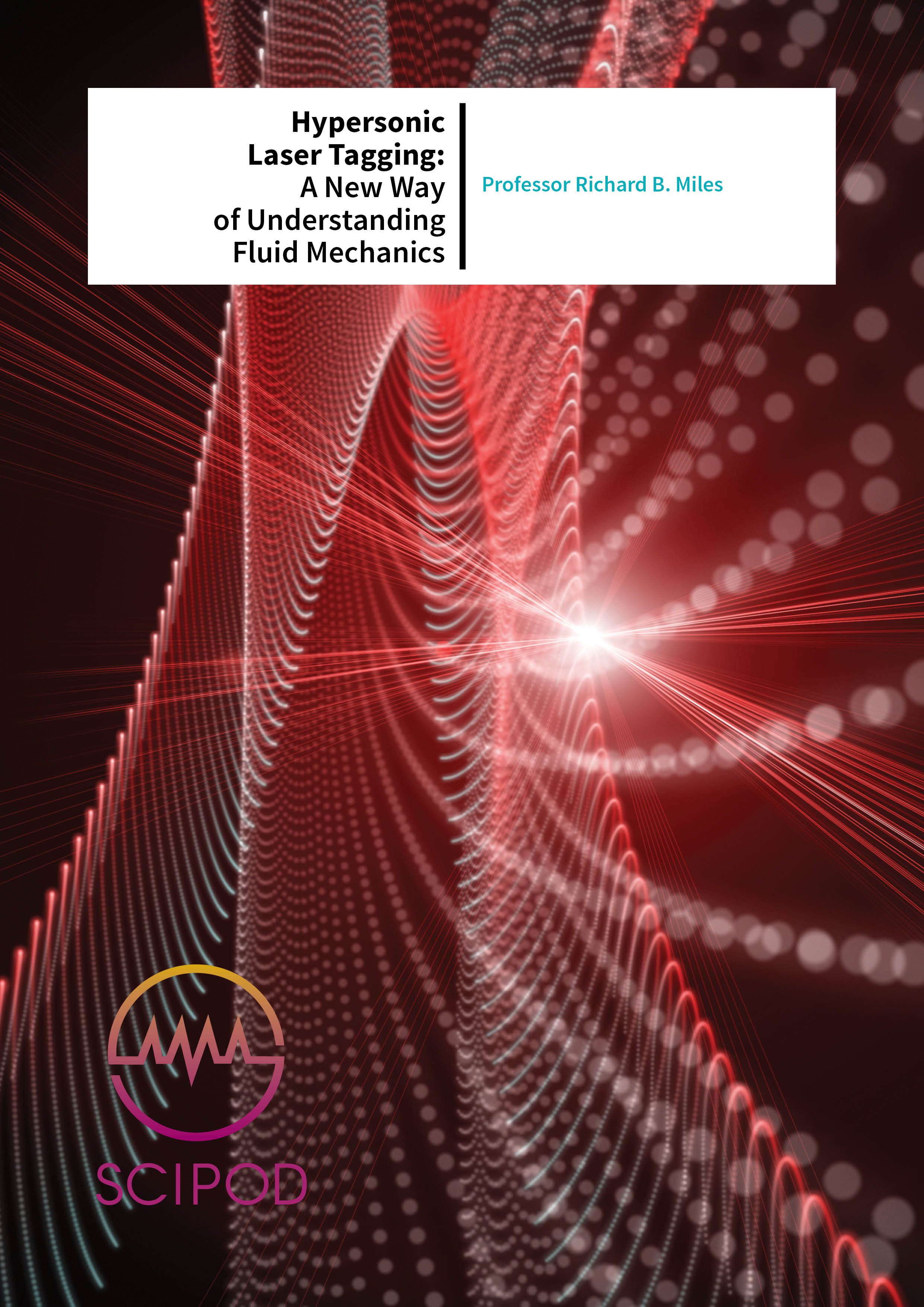Professor Richard Miles – Hypersonic Laser Tagging: A New Way of Understanding Fluid Mechanics
Fluid mechanics is the study of the flows within liquids, gases and plasmas, and the forces that act upon them. Applications involving fluid mechanics are vast, ranging from chemical engineering to astrophysics, and so an accurate understanding is essential for future developments. Professor Richard Miles at Texas A&M University is an esteemed contributor to this field, and his team’s latest breakthrough involves a pioneering way of measuring the velocities of high-speed fluids.
Like a gust of wind or an ocean current, most flows within fluids are invisible to the naked eye, and as such, techniques have been developed to visualise these complex and dynamic patterns. The beginnings of a scientific approach to flow visualisation can be traced back to experiments performed by Leonardo da Vinci. It is said that he would float grass seeds in moving water and sketch their resulting trajectories. After repeated sketches, information about the flow of the fluid could be determined, and by measuring the position of the seeds over time, the velocity of the flow could be estimated in a process known as ‘velocimetry’. Whilst modern velocimetry methods have become much more accurate and intricate, many still use this basic principle, where the flow is ‘seeded’ with particles that can subsequently be observed and recorded.
However, with all techniques that seed the flow, a degree of inaccuracy is incurred. For example, if using smoke to visualise the flow within air, the assumption is made that the smoke particles faithfully follow the fluid flow pattern. In reality, given that they are a different density and consistency, this is unlikely to be the case. Even particles with densities matching that of the fluid may have other physical differences that will cause some disruption to the flow.
An alternative to intrusive seeding techniques is the innovative method of velocimetry known as ‘molecular tagging’. Simply put, this technique uses a laser to chemically or electronically alter some molecules within the flow as they pass through its beam. The molecules that are hit by the laser can then be visually distinguished and are said to be ‘tagged’, but they keep the same physical behaviour as the rest of the fluid. Conventionally, the laser is positioned perpendicular to the flow of the fluid so that a line of tagged molecules is produced from the beam across the whole flow. This then gives a representative sample of the flow, and as this line of tagged molecules is transported by the movement of the fluid, images at two intervals of time are produced to determine how the line of tagged molecules is being displaced or deformed.
What is FLEET?
Femtosecond Laser Electronic Excitation Tagging (FLEET) is a special velocimetry technique developed by Professor Richard Miles and his research team at Princeton University. Central to this effort was the work of Matthew Edwards, Princeton class of 2012, Dr James Michael (now at Iowa State University), and Dr Arthur Dogariu.
Professor Miles has recently accepted the position of TEES Distinguished Professor at Texas A&M University (TAMU) and plans to implement FLEET at TAMU in their high speed aerodynamic facilities. Essentially, the technique takes advantage of unique properties of recombining nitrogen molecules by first dissociating them with a titanium-sapphire laser pulse with tens to hundred of femtosecond duration. This short pulse avoids the formation of bright sparks and enables the writing of lines and patterns of dissociated species into the flow. After dissociation, the nitrogen atoms recombine, forming nitrogen molecules in a high-energy state that emits fluorescent red and infrared light for tens of microseconds (first positive emission).

Figure 1: A single FLEET line tagged across a Mach 3 boundary layer in a nitrogen flow sequentially imaged at three microsecond intervals. Flow is from right to left. Image was taken at the Arnold Engineering Development Complex, White Oak, Maryland.
This extended fluorescence time allows the flow to move far enough for the displacement to be imaged with a fast-shuttered camera, and the displacement divided by the time delay gives the flow velocity. The technique is specifically attuned to nitrogen – the most abundant molecule in air – and so the aerodynamic flows can be followed in real time, without disrupting the flow with foreign gases or obstructive particles. Due to FLEET being non-intrusive on the flow of the fluid and providing an instantaneous profile of the flow, it has the potential to yield unprecedented insights into high-speed fluid mechanics. The ability of FLEET to write patterns into the flow, such as crosses and rectangles, enables the measurement of vorticity, shear stress and other dynamic flow properties.
FLEET is aptly named, because it has the capacity to measure fluid velocity at incredibly high flow speeds. If the camera has a multiple time-gated shutter, the motion of a single line can be followed in real time. For example, Fig. 1 shows sequential 3 microsecond-delayed images of a single line tagged across the boundary layer in a Mach 3 nitrogen flow (flow is from right to left). If a flow is more than five times the speed of sound, it is generally described as ‘hypersonic’, and a non-intrusive way to directly measure the velocity and other properties of these rapid flows has remained elusive for some time. FLEET is able to accurately measure flows from subsonic to hypersonic speed because the laser beam is non-intrusive and pulses in the femtosecond range (quadrillionths of a second). There are other techniques available that can indirectly measure the velocity over this range of speeds, but unlike FLEET, they require two separate lasers, or they require a foreign gas or particles to be added to the flow. More conventional methods using probes disrupt the flow.
Another advantage of using FLEET is that the nitrogen molecules emit visible red light when they are excited by the laser, so there is no need for specialised equipment to detect the tagged molecules in the ultraviolet or infrared spectrum – a standard camera with a time gated intensifier is sufficient. Not only this, but the technique has been shown to be functional at a wide range of pressures and temperatures, and has the ability to measure thousands of samples a second.

The Development Process
In the 1980s, Princeton University developed the world’s first system able to perform the molecular tagging of air. This method was known as Raman Excitation plus Laser Induced Electronic Fluoresce (RELIEF), and worked by tagging the molecular oxygen that is present in air. It proved to be an extremely useful method for measuring the velocities of turbulent flows, and applications of RELIEF made possible the measurement of high pressure, supersonic jets. However, the setup was impractically complicated, by requiring three overlapping laser beams and an ultraviolet sensitive camera.
There was an obvious need for a more practical design, and so Professor Miles and his team put together a transportable FLEET setup so it could be moved to relevant high-speed facilities and be able to track the motion of air and nitrogen in real time. He and his team demonstrated this transportable setup in the ‘nitrogen hypervelocity wind tunnel’, Tunnel 9, at the Arnold Engineering Development Complex (AEDC), at wind speeds of up to 14 times the speed of sound. This work was conducted in collaboration with Dr Eric Marineau and Mr Michael Smith at AEDC and was implemented by Dr Laura Dogariu and Dr Arthur Dogariu in association with Plasma TEC, Inc and Speckodyne, Inc., through a Phase II SBIR grant.
The velocities measured by FLEET were in excellent agreement with the predicted results from standard wind tunnel gauges. Fig. 2 shows the time history of the FLEET measurements taken at a 1 kHz rate along with the predicted velocity of the Mach 14 flow, including the start up and shut down transients. Note that the flow velocity increases during the three-second constant Mach number run due to the increase in temperature of the nitrogen in the wind tunnel settling chamber. This is the first time a direct measurement of the flow velocity has been achieved in this facility.

Breaking New Ground
For the first time, FLEET has also been used to measure three components of a flow’s velocity and acceleration in collaboration with Dr Paul Danehy at NASA Langley Research Center. The measurements were conducted in a jet of pure nitrogen that was injected into air at atmospheric pressure. The femtosecond laser that FLEET uses can be focussed down to a fine point, so that only a small volume is measured in the flow. Because FLEET creates excited points that have long fluorescence lifetimes, they can be measured at several different instances, and by using a cleverly positioned mirror setup, stereoscopic images of the moving FLEET points can be projected onto the camera simultaneously. This allows for three components of the velocity to be measured at once, providing a highly accurate measurement of the three-dimensional flow velocity as well as the acceleration of the flow.
Not only can FLEET determine flow velocity with an excellent degree of precision, but by using it in combination with a spectrometer, it has recently been adapted to measure the temperature distribution within the flow too. Spectroscopy is the study of the interaction between matter and light. When nitrogen molecules are excited they also emit blue light that lasts for only a few tens of nanoseconds. The spectrum of this blue ‘second positive emission’ gives an immediate measure of the temperature within the flow. These temperature profiles are determined within a reasonable uncertainty of 10%, and Professor Miles’ team has performed these measurements at conditions ranging from room temperature to nearly 400°C.
It is predicted that this method of measurement will remain accurate at temperatures far exceeding 1500°C, with velocity measurements being conducted simultaneously without any interference. Very few methods and techniques can simultaneously measure temperature and velocity, and dual measurements such as these become extremely difficult under the conditions of hypersonic speeds and or high-pressure environments. FLEET’s ability to do this has far-reaching applications in industry and any field of fluid mechanics.

Figure 2: Nitrogen flow velocity versus time in the AEDC Tunnel 9 operating at Mach 14. Measured points are black and the predicted velocity profile is shown in red.
A Future in Industry
Most measurement techniques deduce the velocity of a fluid’s flow from indirect methods. Commonly, a so-called ‘pitot tube’ is used to indirectly measure velocity by directly recording changes in pressure. Another method employs a ‘hot-wire anemometer’, which is a simple metal wire device that is heated to above room temperature. As the fluid flows past, it cools the wire. Electrical resistance in most metals is related to temperature, and so, depending on the degree of cooling that occurs, a relationship can be established between the resistance of the wire and the flow speed. These techniques have been applied to a wide range of flows with much success; however, their shortcomings are that they do not directly measure molecular motion, and can also be disruptive to the flow. Also, the approaches of pitot tubes and hot wires have limited adaptability to industry because of the size of the probes cannot be scaled while maintaining high accuracy.
Although there are a variety of different seeding techniques used for measuring velocity in fluid mechanics, adapting these techniques widely to large-scale industrial uses still has not occurred. This is in part due to the requirement of the flow to be seeded with particles or potentially toxic gases, and so most facilities are unwilling to upgrade their current setup to accommodate these seeding velocimetry techniques. Therefore, these ‘unseeded’ techniques developed by Professor Miles and implemented by FLEET have great potential in both small and large scale industrial applications.
The future of FLEET is looking bright – from subsonic to hypersonic flow velocities, under high-pressure or high-temperature conditions, FLEET’s strength is in its simple, elegant design. The revolutionary approach of using one commercially available laser and one camera to directly and non-intrusively measure the velocities of fluid flows in air has the potential to make waves within the industry. Not only this, but FLEET’s aptitude for adaptability is one of its most exciting advantages. By adding a spectrometer, Professor Miles and his team have shown that the temperature of the flow can be determined; however, there is also the possibility to calculate the density of the flow by measuring how much the laser beam is scattered by nitrogen molecules in the air (also known as ‘Rayleigh scattering’). Additionally, the FLEET setup could easily be modified to accommodate several cameras, which would provide a stereoscopic, 3D image of the flow, and by using a camera with a rapid shutter speed, taking multiple images could generate a model of how the flow distorts over time.
Meet the researcher

Professor Richard B. Miles
Department of Aerospace Engineering
Texas A&M University
College Station, TX
USA
Professor Richard Miles received his BS, MS, and PhD in Electrical Engineering from Stanford University. His PhD was conducted under Prof Stephen E. Harris and addressed third harmonic generation of coherent light. While at Stanford, he became a Fannie and John Hertz Fellow. He joined the Mechanical and Aerospace Engineering faculty at Princeton University in 1972, and later served as Chairman of Engineering Physics there for over 15 years. He was named Robert Porter Patterson Professor in 2011 and became Emeritus in 2013. Professor Miles joined the Departments of Aerospace Engineering and Mechanical Engineering at Texas A&M University (TAMU) as TEES Distinguished Research Professor in February 2017. While primarily in Texas, he continues to oversee his Princeton research activities as a Senior Scholar. His research focuses on the use of lasers, electron beams, microwaves and magnetic devices to observe, control, accelerate, extract power and precondition gas flows for supersonic and hypersonic fluid dynamics, combustion, propulsion and homeland defence applications. His research group is widely recognised for inventing new linear and nonlinear optical diagnostics, developing a new understanding of plasma aerodynamic interactions and exploring new concepts for hypersonic ground test facilities.
CONTACT
E: rmiles@tamu.edu
T: (+1) 979 458 2534
W: https://engineering.tamu.edu/aerospace/people/miles-richard
KEY COLLABORATORS
Dr Arthur Dogariu, Department of Mechanical and Aerospace Engineering, Princeton University
Dr Mikhail Shneider, Department of Mechanical and Aerospace Engineering, Princeton University
Dr Andrey Starikovskiy, Department of Mechanical and Aerospace Engineering, Princeton University
Dr Paul Danehy, NASA Langley Research Center
Professor Albina Tropina, Department of Aerospace Engineering, Texas A&M University
Professor Christopher Limbach, Department of Aerospace Engineering, Texas A&M University
Dr Laura Dogariu, Plasma TEC, Inc. and Speckodyne, Inc.
Dr Eric Marineau Arnold Engineering Development Complex Tunnel 9
Mr Michael Smith, Arnold Engineering Development Complex Tunnel 9
Dr Jacob George, MetroLaser, Inc.
Dr Thomas Jenkins, MetroLaser, Inc.
Dr James Michael, Iowa State University, Department of Mechanical Engineering
Mr Matthew Edwards, Princeton University (PhD student)
FUNDING
US Air Force Office of Scientific Research, Hypersonics Program under Dr Ivett Leyva
US Army Research Office, Fluid Dynamics Program under Dr Matthew Munson
US Air Force Arnold Engineering Research Complex
MetroLaser, Inc.
Plasma Tec., Inc.



